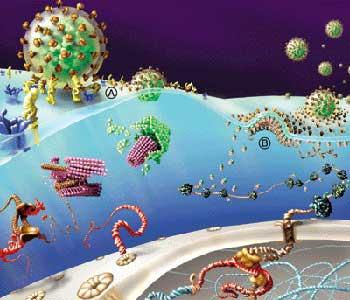The AIDS virus is eliminated from the cell thanks to cholesterol
When the human immunodeficiency virus (HIV) infects a cell, it uses its machinery to form new viruses and spread them to new cells. When entering the cell, the virus is divided into several components and, once the genetic information has been replicated, it is necessary to recollect all the components of the new virus in order to leave the cell.
In this process it collaborates the protein Gag of the virus. This protein binds to the RNA of the virus, proteins and membrane, somehow binds all components of the virus and forms a viral particle. At that time, the virus drives the membrane of the cell and manages to go outside by dragging a part of it.
For this purpose, the Gag protein binds to the membrane of the cell, but not to any area of the membrane, they are only associated to areas or domains very rich in cholesterol (called raft in English). If these sites did not exist, the virus could not go outside.

For this reason, this team of researchers considered that the reduction of the areas of cholesterol in the membrane was to prevent the expulsion of new virus from the cell and its extension. The dispersion of the accumulated cholesterol in these areas has shown that HIV cannot finish its cycle, thereby significantly reducing the production of viral particles.
For this purpose, statins have been used, drugs used to reduce the levels of LDL cholesterol in the blood. At the moment it has only been tested with cells, and at the moment it does not seem that it can be used as an anti-HIV drug. In fact, cholesterol has very important functions in the cell: it organizes the plasma membrane (lipids and proteins), allows intercellular communication and helps to maintain the shape of the cell, among other functions. Therefore, taking medications that undo cholesterol domains can be toxic, as it can prevent the proper functioning of the cells.
With this study, we wanted to highlight the importance of cholesterol domains in the HIV cycle. In fact, cholesterol can also be involved in other steps in the HIV cycle, such as the introduction of the virus.
Buletina
Bidali zure helbide elektronikoa eta jaso asteroko buletina zure sarrera-ontzian











